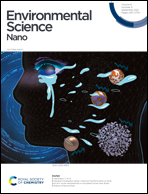Sulfur-containing nitrogen-rich robust hierarchically porous organic polymer for adsorptive removal of mercury: experimental and theoretical insights†
Abstract
The development of an efficient and robust material for adsorptive removal of highly toxic metals like mercury from water resources is very challenging from the perspectives of hygiene and sustainable environment. Heteroatoms such as sulfur and nitrogen in this high surface area porous organic polymer is very promising for mercury remediation because it offers strong interactions between Hg(II) ions and S/N bound at the pore surface of the adsorbent. Thus, herein we developed a new secondary amine-linked, sulfur-containing and N-rich porous organic polymer, TTP-1, via polycondensation of a tetrapodal amine and thiophene-2-carbaldehyde. TTP-1 displayed a high BET surface area of 1034 m2 g−1 with hierarchical porosity and exceptionally high uptakes of 3106 and 691 mg g−1 for inorganic Hg2+ and organic methylmercury (CH3Hg+), respectively. The high adsorption efficiency for mercury capture is also supported from the strong noncovalent interaction of the ligand S and N lone pairs with Hg2+, as revealed from the ab initio quantum chemical calculation and AIM analysis. Cost-effective, eco-friendly and scaleable synthesis of porous organic polymer with hierarchical porosity reported herein may contribute to the design of a benchmark adsorbent for the remediation of mercury (Hg(II)/CH3Hg+) and may significantly aid in industrial and environmental cleanup.



 Please wait while we load your content...
Please wait while we load your content...